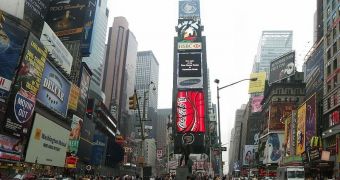Officials at the American space agency announce that the landing of the Mars Science Laboratory (MSL) rover Curiosity on the surface of Mars will be broadcast on the Toshiba Vision screen, in Times Square, New York City.
This will be the largest broadcast location for this event on the entire East Coast. Representatives from the federal agency say that the public will have access to a live coverage of the mission, including the dreaded 7 Minutes of Terror.
The general public must know that Curiosity is scheduled to land on the slopes of Mount Sharp, inside Gale Crater, at 1:31 am EDT (0531 GMT) on Monday, August 6. This rover is the largest and most complex NASA has ever built.
Live coverage of the event will begin at around 11:30 pm EDT, on August 5, and last until 4 am EDT, August 6. The broadcast feed will be transmitted from MSL Mission Control, at the NASA Jet Propulsion Laboratory (JPL) in Pasadena, California.
The Lab, located at the California Institute of Technology (Caltech), manages the mission for the NASA Science Mission Directorate, at the agency's Headquarters, in Washington, DC. Experts at JPL are also in charge of handling the MER rover Opportunity, which is still active on the Martian surface.
“In the city that never sleeps, the historic Times Square will be the place for New Yorkers to participate in this historic landing,” NASA SMD associate administrator John Grunsfeld explains.
“When you think of all the big news events in history, you think of Times Square, and I can think of no better venue to celebrate this news-making event on Mars,” the agency official goes on to say.
Landing a spacecraft the size of a Mini Cooper on the Martian surface is not easy. Curiosity weighs nearly a ton, and has to be deployed using the never-before-tested Sky Crane system. In addition, its deployment depends on a succession of 76 carefully timed pyrotechnic blasts.
Within just 7 minutes, MSL has to decelerate from 13,200 miles per hour (5,900 meters per second) to 1.7 miles per hour (less than a meter per second). This is arguably the most significant stage of the entire landing process.
Curiosity is scheduled to spend at least two years studying the exposed rocky outcrops at Mount Sharp, a mountain-like geological formation that appeared when the massive Gale Crater formed. The mountain most likely formed from ejecta plumes that fell back to the surface.
Geologists believe that it contains diverse geological materials, which could finally enable scientists to determine if lifeforms could have ever endured on the surface of the Red Planet.

 14 DAY TRIAL //
14 DAY TRIAL //